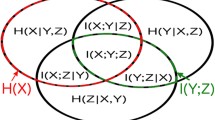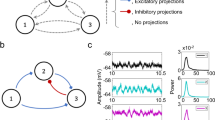Abstract
Multichannel data collection in the neurosciences is routine and has necessitated the development of methods to identify the direction of interactions among processes. The most widely used approach for detecting these interactions in such data is based on autoregressive models of stochastic processes, although some work has raised the possibility of serious difficulties with this approach. This article demonstrates that these difficulties are present and that they are intrinsic features of the autoregressive method. Here, we introduce a new method taking into account unobserved processes and based on coherence. Two examples of three-process networks are used to demonstrate that although coherence measures are intrinsically non-directional, a particular network configuration will be associated with a particular set of coherences. These coherences may not specify the network uniquely, but in principle will specify all network configurations consistent with their values and will also specify the relationships among the unobserved processes. Moreover, when new information becomes available, the values of the measures of association already in place do not change, but the relationships among the unobserved processes may become further resolved.
Similar content being viewed by others
References
Baccalá LA, Sameshima K (2001) Partial directed coherence: a new concept in neural structure determination. Biol Cybern 84: 463–474
Brillinger DR (1975) Time series: data analysis and theory. Holt Rinehart Winston, New York
Chen G, Bessler SL, Ding M (2006) Frequency decomposition of conditional Granger causality and application to multivariate neural field potentials. J Neurosci Methods 150: 228–237
Dhamala M, Rangaranjan G, Ding M (2008) Analyzing information flow in brain networks with nonparmetric Granger causality. NeuroImage 41: 354–362
Ding M, Bressler SL, Yang W, Liang H (2000) Short-window spectral analysis of cortical event-related potentials by adaptive multivariate autoregressive modeling: data preprocessing, model validation, and variability assessment. Biol Cybern 83: 35–45
Ding M, Chen Y, Bressler SL (2006) Granger causality: basic theory and application to neuroscience. In: Schelter B, Winterhalder M, Timmer J (eds) Handbook of time series analysis—recent theoretical developments and applications. Wiley-VCH, Weinheim, pp 437–460
Eichler M (2005) A graphical approach for evaluating effective connectivity in neural systems. Philos Trans Roy Soc B 360: 953–967
Gersch W (1972) Causality or driving in electrophysiological signal analysis. Math Biosci 14: 177–1976
Geweke J (1982) Measurement of linear dependence and feedback between multiple time series. J Am Stat Assoc 77: 304–324
Geweke J (1984) Measures of conditional linear dependence and feedback between time series. J Am Stat Assoc 79: 907–915
Gourieroux C, Monfort A (1997) Time series and dynamic models. Cambridge University Press, Cambridge
Granger CWJ (1963) Economic processes involving feedback. Inform Control 6: 28–48
Granger CWJ (1969) Investigating causal relations by econometric models and cross-spectral methods. Econometrica 37: 424–438
Granger CWJ (1980) Testing for causality—a personal viewpoint. J Econ Dyn Control 2: 329–352
Hesse W, Möller E, Matthias A, Schack B (2003) The use of time-invariant EEG Granger causality for inspecting directed interdependencies of neural assemblies. J Neurosci Methods 124: 27–44
Kamiński M, Ding M, Truccolo WA, Bressler SL (2001) Evaluating causal relations in neural systems: Granger causality, directed transfer function and statistical assessment of significance. Biol Cybern 85: 145–157
Lütkepohl H (1993) Introduction to multivariate time series analysis, 2nd edn. Springer-Verlag, Berlin
Mitra P, Pesaran B (1999) Analysis of dynamic brain imaging data. Biophys J 76: 691–708
Parzen E (1982) Measurement of linear dependence between multiple time series: comment. J Am Stat Assoc 77: 320–322
Thomson DJ (1990) Time series analysis of Holocene climate data. Phil Trans Roy Soc Lond A 330: 601–616
Author information
Authors and Affiliations
Corresponding author
Rights and permissions
About this article
Cite this article
Lindsay, K.A., Rosenberg, J.R. Identification of directed interactions in networks. Biol Cybern 104, 385–396 (2011). https://doi.org/10.1007/s00422-011-0437-7
Received:
Accepted:
Published:
Issue Date:
DOI: https://doi.org/10.1007/s00422-011-0437-7




